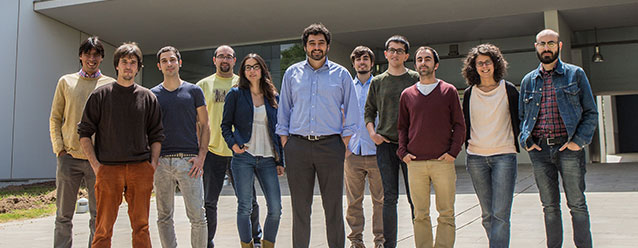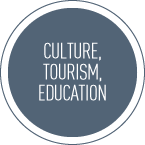Technological Report
Audiovisual

DIRECTOR
Sergi Fernández
TEAM
Mercè López, David Cassany, Pau Pamplona, Marc Fernàndez, Martín Germán, Marc Palau, Núria Campreciós, Marc Aguilar, Gerard Castillo, Ignacio Contreras, Víctor Jiménez
Area description
The Audiovisual Area works on different research, development and innovation areas related to the transmission and visualisation of multimedia contents applied to the media, culture and creative industry sectors.
By means of participation in diverse national and international projects and through a strong collaboration with different industrial partners, an effective improvement has been made in the state-of-the-art in the following areas: content distribution systems, videoconferencing, ultra-high definition systems and mixed reality applications.
Our short and mid-term work is focused mainly on the following R+D+I lines: content management, context aware content adaptation & delivery, content transmission in heterogeneous networks, ultra-high definition, immersive environments and augmented reality applications.
Research Lines
Description and goals
The continuous evolution of communication and computing infrastructures and display devices play a key role that have a strong impact on the underlying content distribution and visualisation systems. The Media Networks group is researching techniques and methodologies to combine global and local content delivery networks (local/global CDNs) and scalable and adaptive video codification and packaging systems (AVC, HEVC, MPEG-DASH, WRTC).
The main goal of this research line is to study and develop efficient software systems to manipulate digital media over the network by using and aggregating the key industry standards. Modular server side services are gaining in relevance as the Cloud Computing Era is becoming a reality. The Audiovisual Area has been researching core services easy to orchestrate that are suitable in this cloudified context, where the delivery and scalability are and will be major objectives.
Keywords/Topics
R+D+i projects
| View | Project | Type of funding | Duration | Project Description |
|---|---|---|---|---|
| View | TV-Ring | EU-CIP – PILOT B | 2013- 2016 | The project explores the great potential of next generation networks and mobile devices in the Connected TV market, which is a strong focus of interest for the media industry. |
| View | MITSU | CELTIC PLUS – Private | 2013- 2014 | The MITSU project develops the next generation of multimedia streaming systems to be used over wireless networks. |
| View | NOTTS | CELTIC PLUS – Private | 2013- 2015 | NOTTS investigates the technical problems experienced by service providers of over-the-top multimedia services, proposes realistic solutions, and evaluates these solutions on testbeds and real networks. |
| View | Visionair | EU-FP7 Capacities | 2011- 2015 | The project’s aim is to create a European infrastructure that should be a unique, visible and attractive entry towards high level visualisation facilities. These facilities must be open to access by a wide set of research communities across Europe and around the world. |
| View | Networked Production | MINECO-INNPACTO | 2011- 2014 | The project aims to evolve the networked production of the audiovisual chain of television and audiovisual content producers. |
| View | Hipermed | MINETUR – AVANZA | 2010 – 2013 | HIPERMED designs an open telemedicine platform based on a unified Service Oriented Architecture (SOA) providing media services, SIP-based control plane services and network services using Internet Protocol (IP). |
| View | Cloud Destination | MINECO-INNPACTO | 2010- 2013 | The project delivers tourism and business oriented solutions for the whole tourist life cycle, promoting smart destinations. The services delivered will use cloud technologies such as Augmented Reality or adaptive video contents, to name a few. |
| View | EffiCity | MINECO-INNPACTO | 2010 – 2013 | EFFICity aims to deepen the SmartCity concept, articulating a new generation network infrastructure to take the advantage of embedding lighting and services that facilitate the efficient management of cities. This will be achieved by combining public lighting infrastructures and embedded technologies. |
Publications
A. J. Gonzalez, R. Martin de Pozuelo, M. German, J.Alcober, and F.Pinyol, “New Framework and Mechanisms of Context-Aware Service Composition in the Future Internet”, in ETRI Journal, vol.35, no.1, pp.7-17, February
M. German, J. Berdun, J. Benseny, W. Pieklik, P. Pawalowski, A. J. Gonzalez, “An Open eHealth Platform for real-time professional-to-professional collaboration”, in Proceedings of IST-Africa 2013 Conference & Exhibition, Nairobi, Kenya, May 2013.
Knowledge progress
The Research Line has acquired relevant knowledge about streaming standards such as MPEG-DASH and more specifically about MP4 encapsulation possibilities. The team significantly improved its background on image manipulation (RGB crop, resize, overlay, etc.) and process parallelisation (using C++11). Finally, with regards content delivery techniques such as content caching or dynamic content adaptation, the researchers gained knowledge in order to perform stable and robust live media streaming.
Prototypes/Proofs of Concept/Services
| Name | Description | Use Case/s | Expected Time to Market (months) |
|---|---|---|---|
| DASH enabled CDN | Proxy caches to encapsulate and distribute live media content over HTTP. | Media distribution for OTT services. | 6 months |
| MPEG DASH transcoder | SaaS to transcode and encapsulate live adaptive MPEG-DASH streams. | Media adaptation (transcode and transrate) to feed OTT services, HbbTV for instance. | 6 months |
| IP AV Mixer | SaaS to perform real time mixing of several streams. | Video Conferencing or IPTV cloud realisation. | 6 months |
Description and goals
This research line works towards the creation of new interactive services in mobile devices. The fast evolution of mobile devices, the daily improvement in their communication and processing capacities, allow us to increase the demand for services which, only a few years ago, were limited to dedicated infrastructures. 3D processing and location-based services are the main research focus of this research line, and in particular, we are addressing augmented reality and the cultural heritage sector as the main technical and market sectors.
Keywords/Topics
R+D+i projects
| Links | Project acronym | Type of funding | Duration | Project Description |
|---|---|---|---|---|
| http://www.i2cat.net/en/projects/i-am | I AM | ENPI-CBCMED | 2012 – 2015 | The I AM project aims to cooperate in and develop applications to enhance the visitors’ experience of natural and cultural heritage sites. It focuses on the use of Augmented Reality (AR), multimedia and interactive techniques. |
| Terrassa + | Private | 2013- 2014 | Terrassa Augmentada is aimed at delivering and enhancing an educative guide of the Modernism period in Terrassa, using mobile and mixed reality technologies to offer a new and engaging experience. | |
| View | Grup Connect-EU MMI | GENCAT – ACC1Ó | 2011-2013 | Coordination of the Media, Mobility and Interaction sector of Catalonia |
| http://www.i2cat.net/en/projects/anticipation | Anticipation | Private | 2012- 2013 | Operative System migration of a specific wifi driver. |
Knowledge progress
The research line has acquired relevant knowledge in the development of mixed reality mobile applications and significant progress has been made in order to create better rendering experiences and accelerate the development of mobile multiplatform applications.
Prototypes/Proofs of Concept/Services
| Name | Description | Use Case/s | Expected Time to Market (months) |
|---|---|---|---|
| Terrassa + App | Mobile application | Education, culture and tourism support services | 4 |
| Empuries Guide App | Mobile application | Education, culture and tourism support services | 8 |
| Thin render | High performance rendering module for mobile devices | Use on mobile apps that need to render potentially huge 3D models in real time | 12 |
| Mobile app development framework for iOS and Android | App development framework | Framework to develop logics and interfaces for mobile apps on iOS and Android, using the same code for both platforms and oriented to highly interactive graphical applications. | 12 |
Description and goals
Digital technologies offer great opportunities for culture, creativity and social innovation.The confluence between technical infrastructures, technologies and the cultural and creative sectors allow us to explore new fields of research and services. The mobile sector is undeniably the driving force of new applications and services. From this research line we focus on the creation of advanced applications and the cultural sector is our main market target. We believe in cultural heritage as the basis of new educational and touristic services and it can be enjoyed from different, new and advanced perspectives, using pervasive gaming technologies and enhancing existing cultural infrastructures.
Keywords/Topics
R+D+i projects
| Links | Project | Type of funding | Duration | Project Description |
|---|---|---|---|---|
| http://www.i2cat.net/en/projects/specifi | SPECIFI | EU -CIP Pilot Actions | 2013 – 2015 | SPECIFI combines NGA and IoT infrastructures and platforms for setting up a European Creative Ring of Smart Cities and Regions facilitating the set-up, customisation, delivery and sharing of innovative, user co-designed arts, media and leisure services locally, regionally, and across Europe. |
| http://www.i2cat.net/en/projects/fi-content-2 | FI-Content 2 | EU – FP7 Capacities | 2013- 2015 | The project is aimed at developing and experimenting cutting edge ICT platforms across Europe devoted to applications and services in the areas of social connected TV, smartcity services, and pervasive games. The project is offered to any European stakeholder, specifically aimed at developers and SMEs access to use these open platforms. |
| http://www.i2cat.net/en/projects/riches | RICHES | EU – FP7 SSH | 2013 – 2016 | The RICHES project researches the context of change in which European Cultural Heritage is transmitted, its implications for future CH practices, and the cultural, legal, financial, educational, and technical frameworks to be put in place for the benefit of all audiences and communities in the digital age. |
| http://www.i2cat.net/en/projects/athenaplus | AthenaPlus | EU- CIP | 2013 – 2015 | Athena Plus is a project which aims to contribute large amounts of content to Europeana, to improve the search and use of Europeana content and to experiment on how enriched metadata can be used for tourism and educational tools and applications. |
| Expo Romànic | Private | 2013-2014 | The Department of Culture (“Generalitat de Catalunya”, the Catalan Government) and Obra Social “La Caixa” jointly promote an Exposition about Romanesque Heritage using advanced media contents and Internet-based innovations. | |
| http://www.i2cat.net/en/projects/rom%C3%A0nic-obert-%E2%80%93-cellers-cooperatius | Romànic Cellers | Private | 2010- 2014 | The Department of Culture (“Generalitat de Catalunya”, the Catalan Government) and Obra Social “La Caixa” jointly promote the “Romànic Obert” and “Cellers Cooperatius” – Cooperative Wineries programs. A presence on the Internet is crucial for the dissemination of strategies. For this reason, a digital platform has been developed for both programs. |
| http://www.i2cat.net/en/projects/elec | EIEC | MINECO- FCC | 2010- 2015 | The goal of EIEC is to create the global Cultural Ring, as a new e-Infrastructure for Culture and the Arts. Partial steps have been launched such as the Cultural Ring in Catalonia, followed by the Latin America-Europe Cultural Ring and the Asia-Pacific Cultural Ring. |
| http://www.i2cat.net/en/projects/linked-heritage | Linked Heritage | EU – CIP | 2011 – 2013 | The 3 main objectives of the project are 1) to contribute large quantities of new content to Europeana, from both the public and private sectors; 2) to demonstrate the enhancement of content quality in terms of metadata richness, re-use potential and uniqueness; 3) to enable improved search, retrieval and use of Europeana content |
Publications
Colobrans, Jordi (2013) “Autoetnografías aplicadas al mundo de la innovación. Usos de las autoetnografías analíticas en la exploración de plataformas informáticas, programas de formación innovadores e investigación de mercados” [Autoethnograpghy applied to the world of innovation. Uses of analytical autoethnology in the exploration of innovative training programs and market research]. In Proceedings of the 11th Spanish Sociology Congress. FES, Complutense University of Madrid, 10-12 July at: http://www.fes-web.org/uploads/files/modules/congress/11/papers/386.pdf
Knowledge progress
The Audiovisual Area team has acquired relevant knowledge about digital library standards and aggregation processes, whilst increasing the level of expertise on eCulture and social innovation projects and services. We have also enhanced our knowledge and strengthened our collaboration with the local creative industry through projects like Specifi and FiContent 2.
I2CAT’s position in the Living Lab and user-centred design sector has been strengthened through the tasks performed in partnership with several local entities and organisations, such as Citilab, Neàpolis or Guifinet. Among these, of paramount importance is the ongoing collaboration with ICUB and Generalitat de Catalunya in the Barcelona Laboratori project, with several actions performed in the framework of the Specifi and FIcontent 2 projects. This ongoing cooperation places i2CAT at the core of the local user-centred innovation ecosystem, and reinforces i2CAT’s leadership in this area.
Market Approach
The Media Networks research line is mainly focused on delivering research and development services as well as the creation of pre-commercial products for the audiovisual and broadcasting sector. These services and products are oriented to facilitate and reduce the cost of IP-based video and audio transmission, and cloud-based processing services. During 2013, different commercial initiatives and projects were launched in collaboration with private and public companies as well as with other research centres. Our main activities at a business level were the development a new cloud-based IP-Mixing solution, in collaboration with ADTEL (http://www.adtel.es/), which will be launched during 2014; and the development of an mpeg-dash packager and the adaptation of an existing and open source CDN project to deliver mpeg-dash over hbbtv 1.5 compliant devices, in collaboration with TVC (http://www.tv3.cat/).
During 2013 we collaborated to a large extent with the Culture Department of Generalitat de Catalunya, and specifically with the museums: the mNACTEC (http://www.mnactec.cat/) and the MAC-Empúries (http://www.mac.cat/Seus/Empuries).

- Museums and Cultural Centers
- Advertising
- Editorials
- Content Producers
- Fair and Events

- TV broadcasters
- Smart connected TV applications
- Content Providers

- Videoconference Providers
- CDN Providers